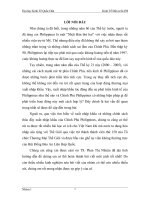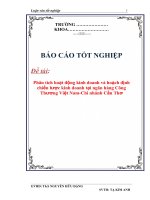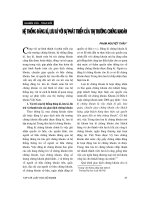BÁO CÁO TỐT NGHIỆP: TỈA THƯA TÁC ĐỘNG TỚI SỰ PHÁT TRIỂN CỦA CÂY THINNING IMPACTS ON TREES GROWTH
Bạn đang xem bản rút gọn của tài liệu. Xem và tải ngay bản đầy đủ của tài liệu tại đây (449.53 KB, 11 trang )
VIETNAM NATIONAL UNIVERSITY OF FORESTRY
FOREST RESOURCES AND ENVIRONMENTAL MANAGEMENT
FINAL REPORT
Title
THINNING IMPACTS ON FOREST GROWTH
Student: Nguyen Huu Dung
Student ID: 1353091031
Subject : Forest Ecology
Class: L03
Advanced Education Program
Developed in collaboration with Colorado State University, USA
Supervisor: Dr. Pham Minh Toai
Ha Noi, June /2017
I.
Introduction
Vietnamese has a locution that: “Forest is gold, ocean is silver, oceans of
money”. To be honest that forests is very important to human life. It is not just
about economic aspects, it is also about roles of forest when forest is a big deal
such as Green lung of our world by many negative effects to environmental
matters : reduce GHGs, global warming, climate change, provide Oxygen, and
also protect our life by reduce natural disasters and so on. With mangrove
forests, it also has many roles included by waves, storms and wind defensing,
etc (Duy, 2014) . However, big question is that how can rise the value and to
manage those gold, it become a big problem and it come to be very
complicated. In that case, a greatest solution was taken that how to raise forest
quality but not much negative effects of that solution? That solution which I
mentioned about is thinning. Thinning has considered to be a optimal solution
for forest management by many positive effects that reduce wildfire risk, tree
competitions for nutrients, water, and lights; or improving quality of trees for
harvesting which considered to be profitable (B. Parker et al 2008). A question
that: “ what are negative impacts of thinning on forest growth which was
considered as a optimal solution?”.
Thinning has defined that: “ In forestry, thinning is the selective removal of
trees, primarily undertaken to improve the growth rate or health of the
remaining trees. Overcrowded trees are under competitive stress from their
neighbors. Thinning may be done to increase the resistance of the stand to
environmental stress such as drought, insect infestation, extreme temperature,
or wildfire.,etc” (Russell T. Graham et al 1999). In other side, key factors
impacts on tree growth rate are nutrients, water, lights etc. In which their
overpopulation of trees and with lack of nutrients, lights, and water. It means
that stress of forest. So in this case, thinning has become the best choice for
managers. Base on secondary data from many authors who defined the thinning
definition that we can clearly understand about roles of thinning in forest
management. However, in this study case, I inherited from a number of
scientific research related to my study case. I would like to give readers a
deeper look about impacts of thinning on forest growth. Hence: Thinning
impacts on forest growth” will help you had a scientific knowledge about
thinning and forest growth from their implications.
II.
1.
Goals and objectives:
Goal
This report aims to prove hypothesis that thinning has closely inter-related to
forest growth and how did they impacts on each other?
2. Objectives
- To indicate key factors impacts on thinning plans
- To indicate and deeply explain about negative and positive impacts of thinning
-
on forest growth
To indicate their implications between thinning and forest growth
III.
Study methods
Data collection
+ Secondary data:
This study mainly depend on results from another authors. In order to prove
hypothesis that thinning impacts on forest growth, I have inherited those results
from recognized researches which related to this report.
Results and discussions
Key factors in order to establish thinning plans
1.1.
Manager decisions in management objectives
It has a belief for sure that manager decisions in management objectives is the
IV.
1.
-
most important factor in order to establish thinning plans. Because managers
who investigate, evaluate and decide what stand will be thinned, how many
trees and what species will be thinned, what are thinning methods will be
-
applied, etc.
With other aspect that economical, it has differences between landowners and
forests belongs to government (Garry Kerr et al,2011). That means with forests
belongs to private company or owners, the manager will be preferred to
economic values more than sustainable management of those forests areas.
Private managers think about how to get more profits from thinning in shortterm in stead of main thinning objectives that reduce wildfire risk or improve
forest health as well.
Figure 1. Key factors to establish thinning plans
-
-
-
-
Because thinning was considered to be profitable with no tax from
government and related fees…etc (PhD, Advisor: John A. Kershaw thesis) .
So that many managers based on this in order to get more profits. Further
more that thinning increase asset value of the remaining crop and also
remaining trees increase in volume faster which allows clear felling to be
completed as quickly as possible.
1.2.
Forest types with forest growth rate
It is very easy to understand that why forest types with forest growth rate
indirectly impacts on manager decisions and thinning plans. Because we can
clearly wondered with differences species, they also have differences growth
rate. For example with species that Santalum Album after 12 years we can
harvest. It means that less than 12 years it could be thinned. But with species
Pterocarpus santalinus upto 22 years we could be harvested.( Dr. Vu Van Toai,
2015). So we can see that each species has different growth rate. With planted
forests that not much mixed species than natural forests. That means with
higher mixed vegetation ratio, we also have higher density of trees. It also
increase competitive between trees or stress of forests.
From this, we can be released that inter-relationship between thinning plans
or thinning and forest growth. In other way, we can prove that thinning
impacts on forest growth and the both of them reacted to each other closely.
By components of species, density of stands, forest types, and their
consequences from all of characteristics.
1.3.
Age of forest
With another periods of time for thinning or for forest growth, we also have
different of thinning plans. Because of with another periods of time in forest
growth, we have differences characteristics for growth abilities, regeneration,
nutrients, lights, and water demanding (Gary Kerr et al 2011)
Figure 2. Age of forest stands with their growth
(Sources: Gary Kerr et al 2011)
-
At the first stage, stand initiation with regenerate naturally, in this stage, tree has
highest growth rate than any stage compare with second, third and fourth stage.
Especially in third stage that understory reinitiation, in this stage, trees has fruits
and seeding can be growth well in this stage. But in all-sized stage, self-thinning
happened because of lack of nutrients, lights, water. It make not good die
included by seeding as well, regeneration and growth abilities in this stage was
2.
slowest.
Positive and negative impacts of thinning on forest growth
2.1.
Positive impacts of thinning on forest growth
-
2.1.2. Thinning is profitable
Thinning is considered to be profitable which I mentioned in introduction. In
other words, we can say that thinning get more and more profits for managers.
In another periods of thinning, cause of improving quality of trees, total of
profits increased over time:
Figure 3. Thinning with their economic value in period of time
-
(Sources: Forestry services Ltd, experienced professionals)
With no taxes from government, from selling woods production in thinning, the
manager can get more profits from 16th year is 400 € per hectare after 3 years is
500 €/ ha. But just after 6 years, total of profits increased 1,100 €/ha and after
11 years has become 1,400 €/ha. In order to get profits likes this, year by year
from thinning, trees quality has increased about volume of trees by increasing
growth rate over time. So that from increasing whole of quality and volume and
-
price together, thinning is profitable with managers.
From that positive impact of thinning, profits could be improve manager’s
behaviors with thinning and management objectives that in stead of preferred to
focus on short-term benefits, managers could be though about long-term. It
means sustainable forest management.
2.1.2. Thinning reduce wildfire risk
-
Thinning influences tree growth rates, economic potential, species
composition, resistance to insects and disease, quality of wildlife habitat, forage
production and visual appearance of a stand of trees. Another very important
purpose for thinning can be added to this list: increasing the ability of a forest to
survive wildfire (B. Parker et al 2008)
Figure 4. Thinning reduce wildfire risk
(Sources: B. Parker et al 2008)
-
Unthinned stand means no trees thinned, light thinning, moderate, heavy
thinning respectively 90% , 90-110% and 110-140% MTI ( marginal thinning
intensity). By reducing density of trees, understory, and fuel ladders that reduce
wildfire risk, especially in dry season. In unthinned stand with highest density
of trees fire will be harder to control and faster in wildfire happen. From tree to
tree, if more space between trees, wildfire can be slower outbreak than
unthinned stand. So from reducing wildfire risk, thinning positively impacts on
forest growth.
2.1.3. Thinning increase photosynthetic rate
- From reducing density of trees, thinning increase photosynthetic rate by make
more spaces between tree to tree. Compare between moderate and heavy
thinning:
Figure 5. Photosynthetic rate related to thinning rate
-
Moderate thinning with 110% Marginal thinning intensity and with heavy
thinning up to 110-140 % MTI, it always has photosynthetic rate higher than
moderate thinning. From that, we can see that total of trees thinned ratio with
photosynthetic rate, and with higher trees thinned, it has higher photosynthetic
rate included comparison with unthinned stands ( David J Suggett et al 2013).
2.2.
Negative impacts of thinning on forest growth
Beside positive impacts of thinning on forest growth, it also negatively impacts
on tree growth when it used more big and heavy machines for transferring, and
cutting. By those consequences, forest growth could be indirectly effected.
Soil compaction
From using some big and heavy machines go through the forest that make soil
2.2.1.
-
strength increased:
-
Figure 6. Soil compaction with root stress threshold
When we applied big and heavy machines, in thinning process those machines
come to the forest and they need the roads for transferring. Between stands,
when machines go inside of stands by gravity force, it compacted to the soil. It
makes soil strength increased more than 1500 kPa and more than 2000 kPa. It
-
negatively impacts on root systems and indirectly impacts on tree growth.
2.2.2. Thinning increase soil erosion
Also from reducing density of trees, thinned trees has removed, it make more
spaces for direct drops from precipitation into soil. From here, detachment
process happened and overland flows carry soils and nutrients come down to
water bodies. May natural disasters happened in rain season with a high of
rainfall at the short time:
Figure 7. Thinning rate related to erosion rate
-
Sources: Ygui Zheng et al 2005
With different thinning rate by MTI, we can see that erosion rate and thinning
rate ratio to each other. With light thinning at 90% MTI, the erosion rate is less
than 0.15 ton/km2/yr. But with higher thinning rate in moderate and heavy
thinning 90-110% MTI and 110-140% MTI respectively , so the erosion rate
increased up to 0.15 and 0.4 tons/km2/yr. So with higher thinning rate, the
-
erosion rate also increased over time.
V.
Conclusion
Thinning was known with many positive effects such as profitable with almost
of managers, increase quality of wood productions, reducing wildfire risk by
-
reduce density of trees respected to improve forest growth by many ways.
This report also give a larger looks for readers by negative impacts of thinning
by soil erosion, soil compaction as well. However to be honest that thinning still
a optimal solution in sustainable management because it resolve the both of
-
issues that economic and sustainability in forest development.
With further study, I would like to recommend a aspects that was a limitation of
my research that effects of thinning on aquatic life and soil ecology cause by
erosion and soil compaction and so on.
Reference:
•
B. Parker et al 2008., Reducing hazardous fuels on woodland properties:
thinning.
•
David J Suggett et al 2013, Thinning effect on photosynthesis depends on
needle ages in a Chinese fir (Cunninghamia lanceolata) plantation
•
•
Gary Kerr et al 2011, Thinning Practice A Silvicultural Guide
Josef Hakl et al 2007, The effects of the soil compaction […] on root biomass.
Tran Van Duy (2014), Environmental effects of tourism on Cuc Phuong
National Park.
Ygui Zheng et al 2005,Effects of thinning on Erosion rate with aquatic life.
•
•









